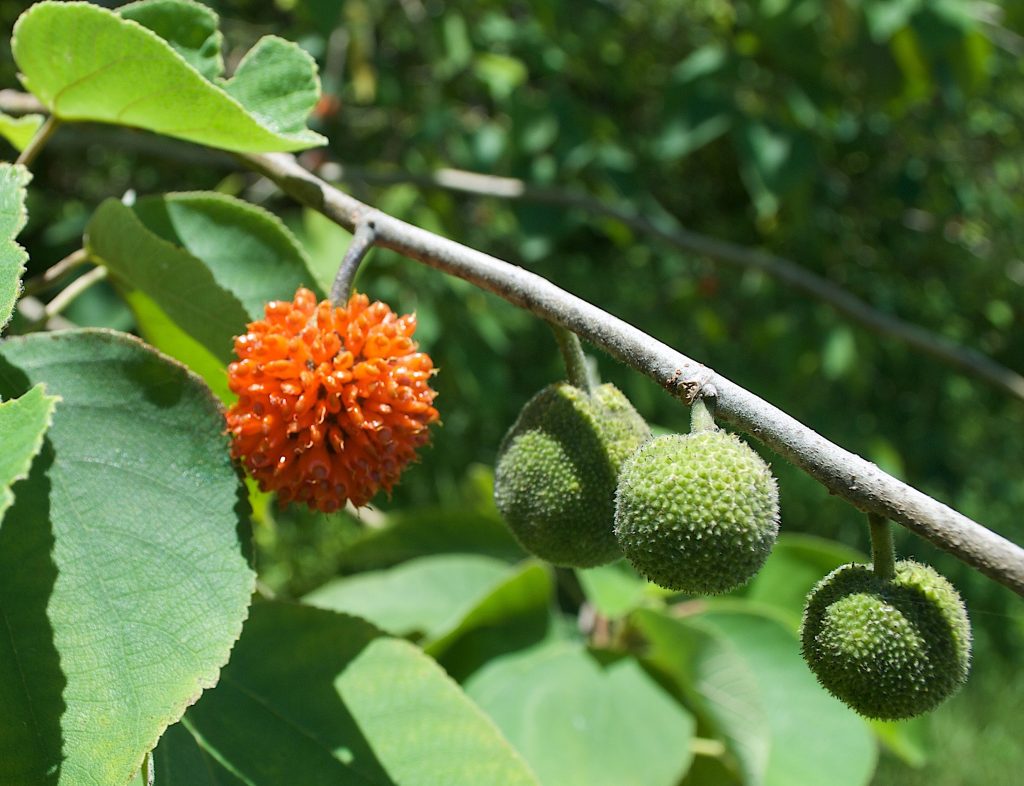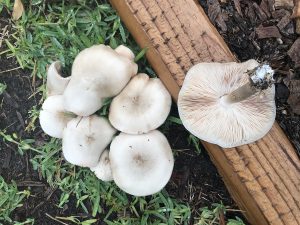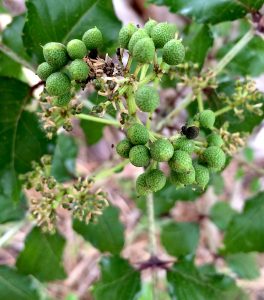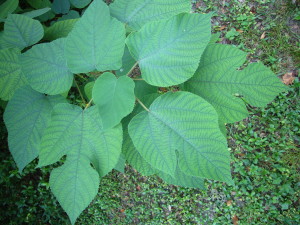
Paper Mulberries are related to bread fruit. Photo by Green Deane
On the east coast of my native state of Maine about seven miles south of Portland is the Town of Scarbrough. There you will find Pine Point and Black Point separated by the Nonesuch River which empties into Casco Bay. These points are less than a thousand feet apart as the seagull flies. Pines predominant on southern Pine Point and the darker-colored spruce on northern Black Point. Why? Soil? Human intervention? No. Ocean current meet at those points making Black Point slightly cooler annually — attractive to spruces — and Pine Point slightly warmer which is more attractive to pines.
Distance and or elevation can significantly affect plant selection and growth. Here in flat-iron Florida a 60-mile separation decides whether our Paper Mulberries pictured above and left, will have fruit or not. In the northern areas of the state the tree is putting on fruit. In the central part of the state it rarely fruits because the winters are usually too warm. The Paper Mulberry is from a temperate climate and prefers cooler temperatures. This past weekend in Jacksonville — 136 miles to the north — the trees were full of “buttons” which will sprout orange pom-pom like fruit. The orange part is edible but not the seed in the middle. Locally Paper Mulberries stay barren (but sneakily can reproduce vegetatively, something the importers had not planned on.) If you want to read more about the Paper Mulberry you can go here.

Classes are held rain or shine or cold. (Hurricanes are an exception.) Photo by Kelly Fagan.
Teaching on both coasts this weekend, Spruce Creek which is south of Daytona Beach and has tidal influence, and Red Bug Slough in Sarasota, always an interesting location.
Saturday, April 1oth, Red Bug Slough Preserve, 5200 Beneva Road, Sarasota, FL, 34233. 9 a.m. to noon.
Sunday, April 11th, Spruce Creek Park, 6250 Ridgewood Ave. Port Orange, 32127. 9 a.m. to noon.
Saturday, April 17th, Jervey Gantt Recreation Complex, 2390 SE 36th Ave., Ocala, FL. 9 a.m. to noon. There is no fee for this class. You can make a donation afterwards if you like. This is because the City of Ocala says I must meet all the requirements of a football team if I want to teach in the park and charge a fee. It is either hold a free class there or never teach in Ocala.
Sunday, April 18th, Dreher Park, 1200 Southern Blvd., West Palm Beach, 9 a.m. to noon.
Saturday, April 24th, Bayshore Park, Bayshore Drive. Port Charlotte. 9 a.m. to noon, meet at the parking loot at the intersection of Bayshore Dive and Ganyard Street.
Sunday, April 25th, Seminole Wekiva Trail, Sanlando Park, 401 West Highland St. Altamonte Springs, Florida 32714. 9 a.m. to noon, meet at the first parking lot on your right after entry.

Deer Mushrooms like deadwood and cool weather. Photo by Green Deane
Deer Mushrooms are edible but not too well liked. They are not difficult to identify down to the genus. And while edible are not sought out because of unremarkable taste and not much body (the caps are mostly gills.) They are better than what you can buy in the supermarket but not as good as many other wild mushrooms. My neighbor had a large Live Oak removed last fall and this spring the roots are sprouting mushrooms, in this case Pluteus cervinus or P. petastus. Necessary microscopic spores analysis requires a microscope stronger than the two I own. However, P. cervinus prefers whole pieces of hardwood in the woodlands, P. petasatus can grow on wood chips in suburbia. The name comes from the fawn-colored patch on top of the cap. Its free gills are whitish at first and become pinkish. The spore print color is pink/salmon.

Shells of the berries can make a pepper substitute. Photo by Green Deane
A couple of hundred miles can make a botanical difference. In Melbourne, some 20 miles south of the space center, we saw a Toothache tree, Zanthoxylum clava-herculis, setting fruit. In Gainesville the same species was getting ready to blossom or had a few here and there. Also called Hercule’s Club, the thorns, bark and leaves have been used at least for centuries to numb aching teeth. It will also make you drool, a small inconvenience to silence an aching tooth. You can read about it here. Many Americans have actually eaten part of a relative of the Toothache Tree, Szechuan Pepper, Zanthoxylum simulans (and Z. bungeanum.) That spice is made from the seeds hulls of the species. We can use the seed hulls of our tree as well. The tree is covered with thorns so approach with care (And another thorny tree we saw was Aralia spinosa, which is not related but is sometimes also called Hercules Club.)

The first 150 of Green Deane videos are now available on a USB.
150-video USB would be a good spring present and is now $99. My nine-DVD set of 135 videos has been phased out. The USB videos are the same videos I have on You Tube for free. Some people like to have their own copy. The USB videos have to be copied to your computer to play. If you want to order the USB go to the DVD/USB order button on the top right of this page. That will take you to an order form. I’d like to thank all of you who ordered the DVD set over the years which required me to burn over 5,000 DVDs individually.

Green Deane Forum
Want to identify a plant? Perhaps you’re looking for a foraging reference? You might have a UFO, an Unidentified Flowering Object, you want identified. On the Green Deane Forum we — including Green Deane and others from around the world — chat about foraging all year. And it’s not just about warm-weather plants or just North American flora. Many nations share common weeds so there’s a lot to talk. There’s also more than weeds. The reference section has information for foraging around the world. There are also articles on food preservation, and forgotten skills from making bows to fermenting food.
 Your donations to upgrade the EatTheWeeds website and fund a book were appreciated. A book manuscript has been turned it. It had 423 articles, 1315 plants and a third of a million words. What it will be when the publisher is done with it next year is unknown. Writing it took a significant chunk of time out of my life from which I have still not recovered. (Many things got put off.) The next phase is to update all the content on the website between now and publication date. Also note as it states above the 135-video DVD set has been phased out for 150-video USB. Times and formats change.
Your donations to upgrade the EatTheWeeds website and fund a book were appreciated. A book manuscript has been turned it. It had 423 articles, 1315 plants and a third of a million words. What it will be when the publisher is done with it next year is unknown. Writing it took a significant chunk of time out of my life from which I have still not recovered. (Many things got put off.) The next phase is to update all the content on the website between now and publication date. Also note as it states above the 135-video DVD set has been phased out for 150-video USB. Times and formats change.
This is weekly newsletter #452 If you want to subscribe to this free newsletter you can find the sign-up form in the menu at the top of the page.
To donate to the Green Deane Newsletter click here.



Can’t wait for the book to be published.
How long does it normally take for the USB to be delivered?
Only a few days if I’m on the ball…